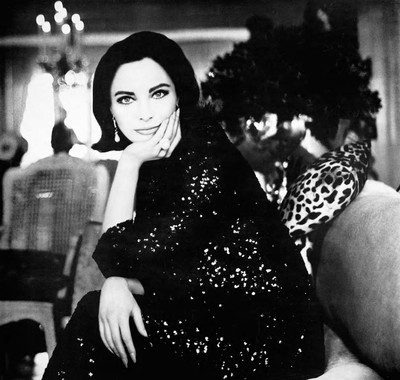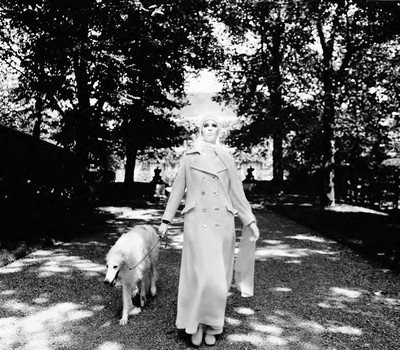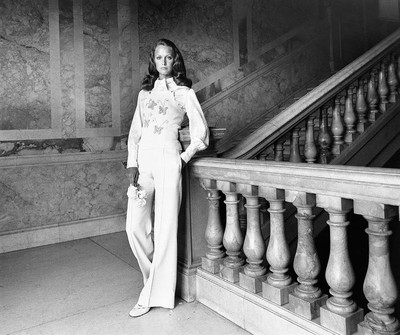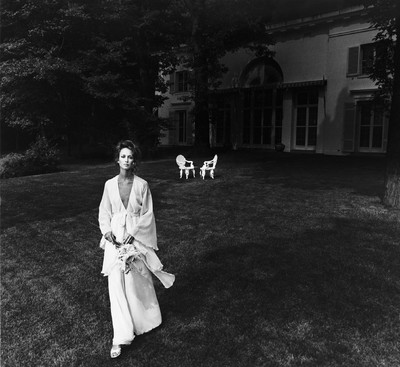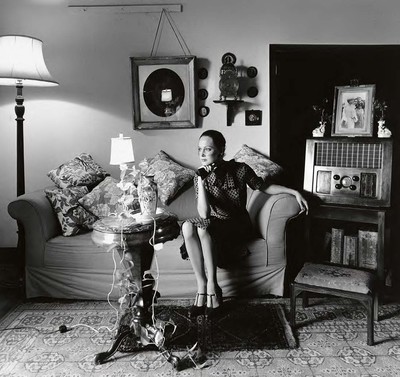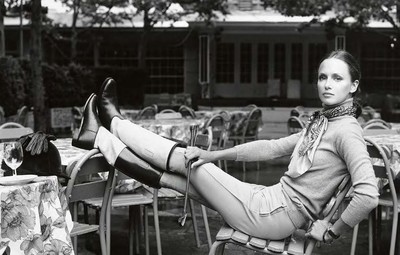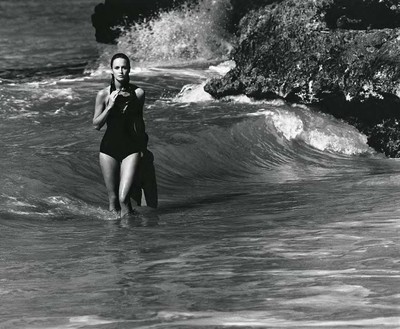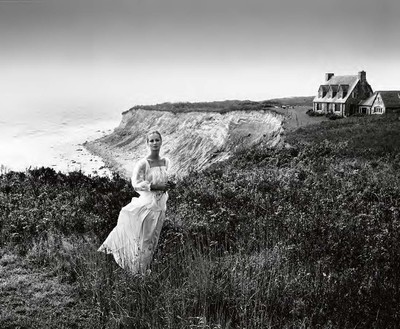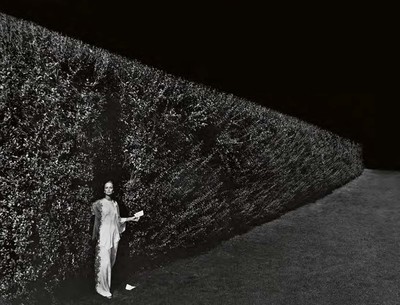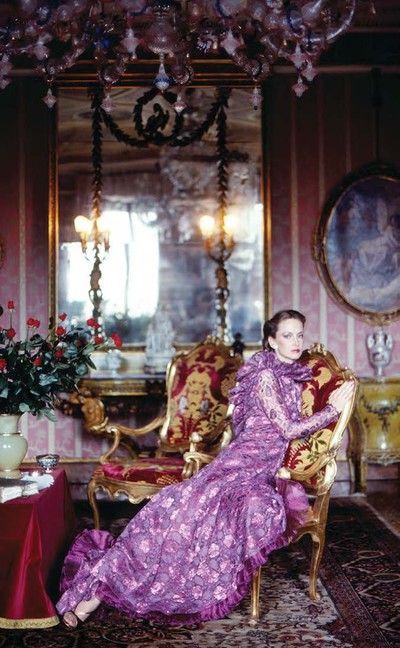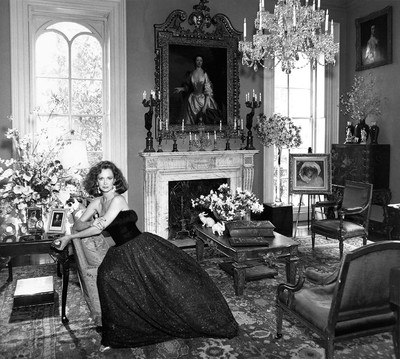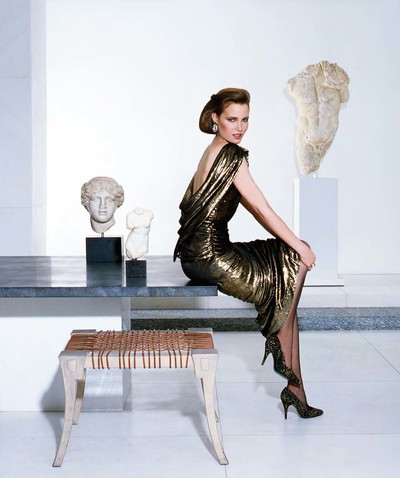Victor Skrebneski, fashioning the face of Estée Lauder.
By Alex Aubry
Victor Skrebneski, fashioning the face of Estée Lauder.
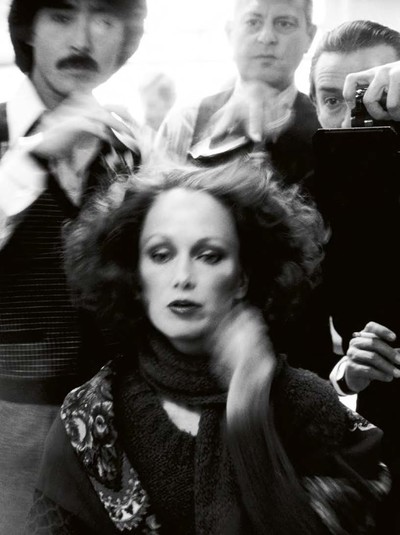
Estée Lauder’s advertising campaigns were always about more than selling her beauty products. She once proclaimed that they chronicled not just standards of beauty, but also trends in fashion, movements in interior design and changes in lifestyle. Communicating more than just powder and paint, today the beauty company’s portfolio of advertising campaigns shot by the legendary photographer Victor Skrebneski between 1962-1989 have acquired a life of their own.
Lauder once described his work as ‘peerless’, and long before the term ‘lifestyle branding’ crept into fashion’s lexicon, Victor Skrebneski was crafting seductive worlds through his photographs, capturing an ephemeral sense of luxury – perfect for selling everything from tweed blazers to bottles of per- fume. For over 60 years, he has used his expert lens to capture fashion’s mood swings and our evolving notions of beauty.
As legend has it, Skrebneski found his passion early in life – literally. At the age of six, he found a lost camera on a Chicago park bench. It changed the course of his life. ‘I didn’t even know what it was. It was just this black box,’ he recalled. ‘My father would take my sister and I to this park every day, and I took the black box to the people in the field house. A couple of weeks later, when no one had claimed it, they said I could have it.’ That simple fold-out camera launched Skrebneski on a journey that would transform the Chicago native into one of the world’s most prolific fashion, beauty and portrait pho- tographers, earning him a place in history amongst the likes of Irving Penn, Richard Avedon and Robert Mapplethorpe.
Like them, his atmospheric black-and-white images have appeared in prestigious publications such as Vogue. Similarly, he has helped launch the modelling careers of iconic faces such as Wilhelmina and Cindy Crawford, while his unguarded and intimate celebrity portraits include a menagerie of cultural icons from Liza Minnelli to Andy Warhol – in the celebrated ‘black turtleneck series’. This prolific body of work has earned Skrebneski respect as both a photographer and artist through countless awards, books and museum retrospectives. This autumn, Skrebneski was honoured with the prestigious Lucie Award at New York’s Carnegie Hall, for his contributions to the field of photography.
‘Long before the term ‘lifestyle branding’ crept into fashion’s lexicon, Victor Skrebneski was crafting seductive worlds through his photographs.’
Born in Chicago in 1929 to parents of Russian and Polish heritage, Skrebneski studied painting and sculpture at the Art Institute of Chicago, but, as he recalls: ‘The Art Institute was boring because I knew how to paint. Nothing to it.’ He had a stint at the Moholy-Nagy Institute of Art and Design in Chicago, but he found his metier when a friend gave him his darkroom equipment, and Skrebneski went to work enlarging and crop- ping the photographs he had been taking since he was a child.
His introduction to the fashion world began in the early 1950s. After showing his photographs to Harry Callahan, who taught photography at Chicago’s Institute of Design, he was urged to show his work to a number of New York editors, telling him he had never seen cropping like his before, and soon Skrebneski was shooting for magazines such as Glamour and Esquire.
Shortly after returning to Chicago to pack and move permanently to New York, the then 23-year-old received the first of many assignments from Marshall Field’s department store. ‘Marshall Field’s kept pouring out the photographs that I was doing, so I figured, I’m going to do the same thing out in New York, so why not just stay here? And that’s what I did,’ says Skrebneski, who established his Chicago studio in 1952. Although most publications credited with making a fashion photographer’s career are based in New York, Skrebneski flourished in Chicago. And by attracting the attention of influential tastemakers, instead New York began to come to him, and he was soon shuttling between the world’s fashion capitals. ‘Victor is a Chicago boy who never left home but became a citizen of the world through the medium of his art,’ noted Frank Zachary, Town & Country’s influential Editor-in-Chief from 1972-1991. ‘Impeccably composed, immaculately rendered, the Skrebneski photograph is his universal passport.’
If his name isn’t familiar to some, his work certainly is, for despite his recognition as an artist, Skrebneski doesn’t shy away from fashion’s more commercial pursuits. An accomplished image-maker, he has been called upon to shoot some of the most memorable ad campaigns of the past 60 years. Many have come across his patrician portraits in Ralph Lauren’s stores or his Chanel No. 5 ads featuring Carole Bouquet, all Parisian cool and elegance as she stares back from the pages of magazines and billboards.
‘I prefer shooting ads over editorial pages,’ says Skrebneski recalling disagreements with editors when it came to laying out his images. ‘Now if I shoot fashion stories or editorials, it’s because I want to see my work the way I shot it. I don’t need anybody to crop my photographs for me.’
Skrebneski’s penchant for storytelling through imagery was at its most potent during his time as Estée Lauder’s exclusive photographer, a 32-year collaboration during which he worked with only six models: Phyllis Connor (1962-67), Karen Harris (1967-1970), Karen Graham (1970-1980), Shaun Casey (1981-1985), Willow Bay (1985-1987), and Paulina Porizkova (1988-1993). The result is a portfolio of timeless images that defined the tastes and aspirations of generations of women across America and the world.
At his LaSalle Street home and studio in Chicago, a former coach house where Skrebneski has lived and worked for over 60 years, the walls are lined with iconic photos of the fashionable and notorious who posed for him. Amongst the framed images is one of close friend Hubert de Givenchy with his muse Audrey Hepburn, while another of Iman and David Bowie was taken shortly before their wedding. Long considered a Chicago icon, the street outside bears a sign that reads Victor Skrebneski Way, while inside, seated at a desk in his studio, the photographer pours over a decade’s worth of images shot for Estée Lauder’s ad campaigns. A glamorous Karen Graham dressed for evening in a stately living room and wearing Private Collection, or sitting languidly on a terrace in White Linen, waiting for tea to be served.
Insisting his images should speak for themselves, Skrebneski is not about to pause and take stock of his oeuvre; he is notoriously reticent when it comes to discussing his work, let alone his tenure at Estée Lauder. ‘I’m a photographer. I don’t usually talk about the way I work,’ confides Skrebneski. ‘It’s an intuitive process. A photograph is a mood, capturing an event or how you feel at a particular moment in time.’ His method of working is entirely conducted on his terms, and he has a reputation for being a perfectionist amongst editors, art directors, models and anyone else he encounters.
‘The Estée Lauder woman was Caucasian, slender, blessed with elegant swan neck, soaring cheekbones and classically proportioned facial features.’
Recalling his first meeting with Mrs Lauder at the com- pany’s Fifth Avenue headquarters, Skrebneski says, ‘She was very sweet and nice to me.’ Ironically Skrebneski never met Lauder in her oft-photographed 40th floor office with its ornate desk, Champagne-coloured sofa, lush carpet in the right shade of Lauder blue and countless framed pictures of her with Princess Grace of Monaco, the Duchess of Windsor, Prince Charles and Princess Diana; it was the perfect backdrop for many a PR image. ‘The office I met her in was simpler and smaller. I guess that’s where she worked,’ notes Skrebneski.
‘This is the picture that launched my career with Estée Lauder,’ adds the photographer, pointing to an image of a model with broomstick Elizabeth Taylor eyelashes, outlined pale lips and a neat chignon. This photo landed on Lauder’s desk when she was searching for a face to cast in her first ad campaign. The face in question belonged to Phyllis Connor, a Chicago-based model whom Skrebneski had discovered. ‘It was originally supposed to be an ad for Marshall Field’s. Estée Lauder took one look at it and said, “That is the face of Estee Lauder,”’ says Skrebneski, who also noted Phyllis Connor’s talent for instinctively knowing what he wanted to project in an image. ‘One doesn’t find models like that any more. She gave a lot to the camera and could move her fingers ever so slightly to bring emotion to a photograph.’
At a time when cosmetics companies used different advertising agencies to produce campaigns for each country they sold in, Estée Lauder made the decision to maintain a single global image when she launched her first campaign in 1962. Consistency was essential in the visuals and this became Skrebneski’s responsibility. More revolutionary was the company’s decision to use the same model in its advertising photography over a run of several years. ‘Our competitors used many models to speak for them. We felt that there was what we came to call the Estée Lauder woman,’ recalled Lauder. Over the course of several decades a handful of women would be called upon to personify the founder’s ideal of elegance, and although each face projected a different kind of physical beauty, they had much in common: Caucasian women, slender but not excessively thin, blessed with elegant swan necks, soaring cheekbones and classically proportioned facial features.
The ads were a reflection of Mrs Lauder’s own idea of a woman of taste and sophistication. ‘I didn’t need a tiger woman to sell lipsticks,’ she once noted. ‘My women are too fine and, more important, too smart to be taken in by crudeness. My women are elegant achievers. They are independent.’ Over the decades, her campaigns came to embody a feminist manifesto – the models are never dehumanised or objectified. Whether selling a tube of lipstick or a jar of night cream, the photos never focused on just eyes or a mouth to the exclusion of the whole face, the Estée Lauder woman was always depict- ed as a whole woman displaying a characteristic expression of cool don’t-mess-with-me reserve.
She was a woman Lauder described as being ‘in charge of her life, which was perceived as a good life by millions of women who identified with her and strove to be like her. She could be a career woman or a homemaker, but whichever she chose she was successful. And she had a certain indefinable air of class.’ In Skrebneski, Lauder found an equally talented myth maker to conjure up this ideal woman. ‘Estée Lauder was a master at myth-making and a great marketer, and she wanted to convey this genteel aristocratic world,’ says the photographer. His ad campaigns came to personify the fiction the brand wanted to project.
Pulling out one of the first photographs he shot of Karen Graham in 1970 standing by a marble staircase, Skrebneski notes that it was one of Lauder’s favourite pictures of the model, ‘because there was a dignity and elegance to it that captured her vision of what the Estée Lauder woman should be.’ To achieve the distinctive Lauder look – an aura of imperturbable elegance and monied know-how – Skrebneski spent the better part of three decades working with a team that included Alvin Chereskin, the President and Creative Director of Lauder’s advertising agency, AC & R, June Leaman, Senior Vice-President of Creative Marketing at Estée Lauder, and the noted Japanese hairstylist Yusuke Suga.
‘Whether selling a tube of lipstick or a jar of night cream, the photos never focused on just eyes or a mouth to the exclusion of the whole face.’
Owing more than a nod to cinematic lighting effects and film-still poses, Skrebneski’s preference for black-and-white photography can be traced back to his childhood. ‘When I was a kid my father would take me to see black-and-white films by Jean Cocteau at the World Playhouse Theater. I was raised on them, so I don’t think of colour as being immediate. I don’t think of colour as being real.’ On close observation Skrebneski’s photos reveal subtle narratives, inviting the viewer into the subject’s world. One atmospheric 1976 shot of Karen Graham standing in a field overlooking the ocean resembles a moody Scottish pastoral scene. ‘This was actually taken in Montauk, though it could have been in Scotland. It was only later, after the shoot, that we found out the house in the background belonged to Richard Avedon,’ confides Skrebneski.
Even those with little interest in Estée Lauder’s cosmetics or its skincare line will find it hard to mistake the message in the company’s advertising. Representing more than a product, it’s a world filled with seductive illusions of what it’s like to have good taste and the old money to pay for it. ‘Two months ahead of a shoot, we start pulling it all together. We have location finders, a hairstylist, make-up artist, model, photographer, photographer’s assistant, fashion stylist, publicist and art directors, in all about 15 people to carry out these shoots four to six times a year,’ recalled June Leaman in an interview. ‘June would usually come up with the locations,’ noted Skrebneski. ‘She would say, “I want to do Venice this year!” And a location scout would find the places for us to shoot in. But prior to the actual day of the shoot, we didn’t have a theme or a specific idea in mind for a photograph. It would all come together instinctively.’
Whether the setting was a sumptuous private home in New Orleans or the Greenwich Village studio Skrebneski once maintained, rails of designer dresses were inevitably called in from the likes of Oscar de la Renta, Halston and Valentino, in addition to a remarkable assortment of accessories and interior design details. The backgrounds of the ads were so craftily assembled that over the years the cosmetic company received thousands of letters and phone calls from individuals interested in acquiring a piece of the elegance: a table cloth, a sofa or an Oriental vase. ‘Those photographs caused a lot of public comment. People were interested in everything in the picture,’ says Skrebneski. ‘The designers whose dresses were shown did quite a lot of business, and I was always being asked where we had got hold of an item of decoration.’
A lesser-known fact about the photographer is that he is also a designer. For Estée Lauder, Skrebneski was happy to decorate his sets with Chinese vases, Pablo Picasso ceramics and well-stocked bookshelves. Since Lauder aimed its products at higher-income women, the ads had to project an aura of luxury. Whether shooting in a Venetian Palazzo or an Upper East Side townhouse, the photographer would always include various props such as dolls, horses, and curiously, in a 1981 ad featuring Karen Graham, a framed photograph of Nicholas II, the last tsar of Russia. ‘I love to design photographs, to con- sider the proportions of the figure, the space around it, the edge of the picture,’ says the photographer, whose carefully choreographed interiors also helped his models get into character. ‘When you’re trying to project an image of classic elegance, all those beautiful settings fed right into the persona I was working towards,’ noted Karen Graham.
‘Karen Graham played her role as the Lauder woman so convincingly that people unfamiliar with fashion assumed she was Estée Lauder.’
Skrebneski admits that what surrounds him in his daily life shapes the way he takes pictures. Not surprisingly, he arranges possessions in his home as carefully as he arranges an advert. Climbing the concrete staircase to the spacious apartment above his studio, he points to a 17th-century Italian wood figure standing in the hall. ‘I bought this at a gallery in New York from Andy Warhol in the early 1960s,’ he explains. ‘I think he was working there back when he was still illustrating shoes for Bonwit Teller.’ Skrebneski takes an intuitive approach to decorating, noting that ‘beautiful things work well together.’ His instincts dictate where things should go. His home – which has been used as a backdrop for his portraits – is an ultra chic, modernist space furnished with a mix of exquisite 18th-century French furniture, Cubist art, a bronze by Max Ernst, a sculpture by Man Ray, floating on gleaming travertine marble floors.
The success of Skrebneski’s photographs can be attributed to the close relationships he formed with his models. Karen Graham, whose 15-year contract with Estée Lauder became one of the longest working relationships with a model and beauty company, played her role as the Lauder woman so convincingly that over the years people unfamiliar with the fashion and modelling world assumed she was Estée Lauder – a misconception the real Mrs Lauder did nothing to dispel. ‘She really gave to the camera, and you were able to feel the emotion in her eyes. I think that is a very rare trait to find in models today,’ notes Skrebneski of Graham’s ability to channel emotion like a silent movie star. ‘She always knew what to do without me even telling her,’ he adds holding up his favourite image of the model shot inside a house in Jamaica.
Almost two decades have passed since the photographer shot an ad for Estée Lauder, yet there is still much to be learnt about beauty and style from Skrebneski’s photographs, perhaps the most important lesson of which is that youth does not hold a monopoly on beauty. Many an Estée Lauder model continued to pose for the company well into their thirties thanks to the photographer’s encouragement. To Skrebneski, a woman is never too old to be beautiful or photographed, and he scoffs at the use of teenage models in fashion publications and runway shows. ‘You can’t expect 15 or 16-year-old girls to understand that they’re wearing something elegant, or what elegance is, unless they are great students of history, and read and enjoy books,’ observes the photographer. It was that very ingredient of knowing that infused Estée Lauder’s classic beauties with depth and character.
In 1999, the photographer reunited with Karen Graham to shoot an ad campaign for Estée Lauder’s Resilience Lift face cream, aimed at mature women. Of her decision to return to modelling, Graham, who was 54 at the time, noted: ‘It’s insulting when products for someone my age are modelled by 17 year olds. You don’t have to be flawless to be beautiful. Laugh lines are good.’
It is a sentiment shared by Victor, who, at 85, has no intention of resting on his laurels, continuing to expand his body of work: ‘I think that life is too short to begin with, and I still have a lot that I want to do, so I’m always eager to move on to new projects. I enjoy doing it. That’s all.’
